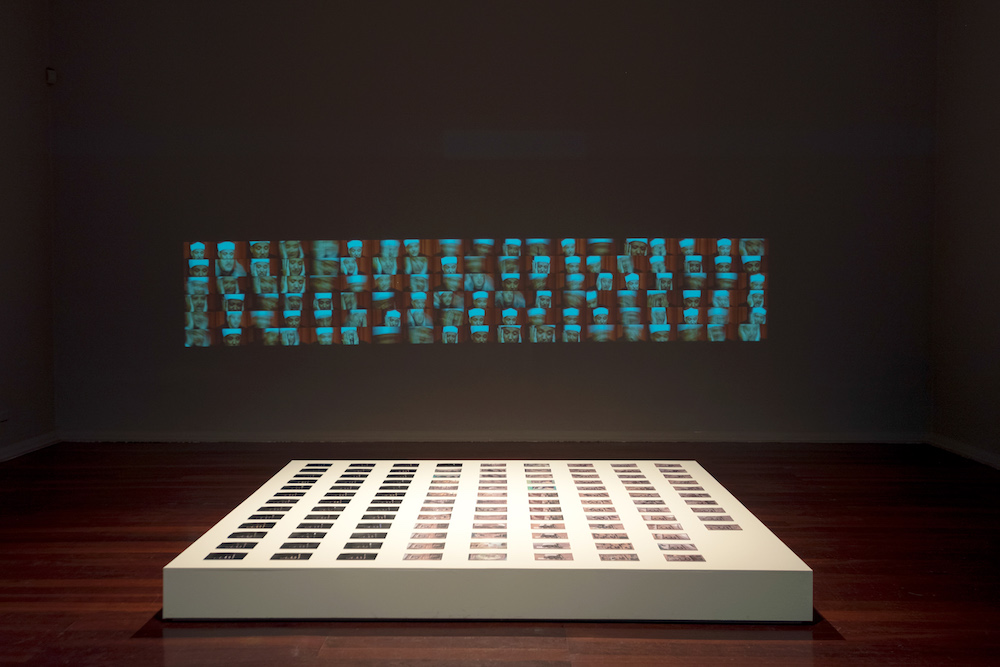Please Open Hurry – Amalia Pica (August 4 – October 7)
A Self Portrait – Khaled Sabsabi (August – October 7)
With this season’s exhibitions, the lower floor of PICA has been cast into darkness, with artworks telling a pressing message under the spotlight. A Self Portrait is a collection of works by Khaled Sabsabi, looking into displacement, marginalisation, and disparities in ideology. With an upsurge of culturally motivated violence, Sabsabi looks to generate co-existence despite differences.
Khaled Sabsabi was born in Lebanon and moved to Sydney in 1978 at a young age, following the civil war outbreak in Lebanon in 1975. A Self Portrait features works from Sabsabi’s oeuvre that span over a period of eleven years.
The majority of the exhibition is a manipulation and experimentation of film, photography, and sound. The exhibition space is dramatic and pointed: sounds of worship emit from a work in the back corner of the gallery, filling the whole space with a spiritual presence. Sabsabi has a religious undercurrent in the majority of his works, with the intention of cultivating an understanding of Islam as a religion of peace.
A Self Portrait (2018) utilises photographs Sabsabi had captured between the years of 2002 and 2013 on his return trips to Lebanon. The photographs have been manipulated and placed in layers of seven to represent the seven layers of the “Nafs” (the self). Inscribed on each photograph is “Allah” in Arabic script.
Three large screens hang in the centre of the main exhibition space, displaying the video installation, We Kill You (2006). Sabsabi delves into contested histories and misconceived realties with his use of archival footage and a monologue akin to a public service announcement. Running the perimeter of the exhibition space is Guerrilla (2007-17) a work comprising of 99 hand-coloured photos. These images show the ruins of Beirut, a city that was once considered the Paris of the Middle East, and highlight the presence of conflict that now resides in this city.
Intolerance and hate crimes against Muslims have become widespread; Sabsabi recognises that fear lies at the heart of this violence and intolerance. His exhibition, A Self Portrait, works toward establishing an understanding of Islamic culture so there is no longer a fear of the unknown and we can move towards co-existence.
The second exhibition currently on display at PICA is by artist Amalia Pica who also looks at co-existence. Pica investigates communication and modes of exchange outside the limits of language. Please, open, hurry examines the ability to communicate with Great Apes, as inspired by methods primatologists have been testing over the last fifty years and Pica’s own artistic residency in 2014 at the Gashaka Primate Project in Nigeria.
When you first ascend the stairs, the viewer is welcomed by white sculptural hand casts spelling out in sign language the title of the exhibition. ‘Please, open, hurry’ is a simple phrase Washoe, a chimpanzee, used to indicate she wanted to play outside.
This exhibition space is very minimalistic and spacious in comparison with the exhibition on the entry level. Amalia Pica brings the natural habitat inside the gallery walls with soundscapes and the audience is first caught off guard when the booming call of a great ape echoes out across the space.
The most dominant work in the main exhibition space is Yerkish (2018), a large display of lexigrams. This system of communication uses visual symbols that correlate to objects or ideas. The audience is left to decipher the meaning of the lexigram in much the same manner as the primate would.
Pica wishes to discuss the possibility of humans learning the apes’ spontaneous behavior, rather than pushing different species to communicate with human methods. In alphabetical order (catalogue of great ape gestures) (2018) is choreographed performance using the gestural behaviours of the Great Apes to form a dictionary of language for humans to use to communicate with Great Apes.
The current exhibitions at PICA, both curated by Eugenio Viola, hold didactic value. Both Khaled Sabsabi and Amalia Pica look at moving away from a narrow, anthropocentric perspective of the world and using alternative methods for co-existence.
Jessica Cottam
Feature Image: Khaled Sabsabi, A self-portrait, 2014-2018
Photo by Alessandro Bianchetti, courtesy the artist and Perth Institute of Contemporary Arts.

